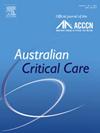建立新生儿重症监护病房和中级监护病房压力损伤风险预测模型的多中心前瞻性研究
IF 2.6
3区 医学
Q2 CRITICAL CARE MEDICINE
引用次数: 0
摘要
背景:住院婴儿压力损伤(PIs)、危险因素和预防措施之间的关系尚未得到广泛研究。目的探讨住院婴儿PIs的发生率、相关危险因素及预防措施,并建立风险预测模型。方法对意大利2个三级新生儿重症监护病房和2个新生儿中级监护病房住院的婴儿进行了一项多中心、前瞻性队列研究。收集社会人口学和临床信息、意大利新生儿皮肤风险评估量表(i-NSRAS)评分、医疗器械的存在、风险因素、预防措施和PI特征,并使用单变量和多变量分析进行评估。此外,决策树技术应用于分析最能解释新生儿群体中pi发生的变量。结果共纳入新生儿209例。40名婴儿共发生62例PIs;累计发病率为19.1%。在重症监护病房,累积发病率为26.4%,而在中级监护病房,累积发病率为8.3%。pi分为I期,38.7%;II期,53.2%;III期,8.1%。最常见的部位是鼻子,占46.8%。多因素分析确定以下危险因素:i- nsas评分(相对危险度[RR]: 0.81;95%置信区间[CI]: 0.69-0.94;p = 0.007);镇静(RR: 7.35;95% ci: 1.67-32.40;p = 0.008),局部减压装置(RR: 4.41;95% ci: 1.3 ~ 14.38;p = 0.014),空腹(RR: 5.04;95% ci: 1.37-18.47;p = 0.015)。决策树检测到i- nsas评分≤17和局部减压装置是最能解释婴儿pi出现的变量。结论婴幼儿PIs发生率较高,尤其是危重患儿,主要与医疗器械的存在有关。所构建的临床树状模型可以很容易地预测住院婴儿PI的风险,从而应用有效的预防策略。为了根据客观标准评估的风险分配预防措施,我们建议应用预测模型作为PI战略预防计划的一部分。本文章由计算机程序翻译,如有差异,请以英文原文为准。
Multicentre prospective study to establish a risk prediction model on pressure injury in the neonatal intensive and intermediate care units
Background
The association between pressure injuries (PIs), risk factors, and preventive measures in hospitalised infants has not been extensively studied.
Objective
The aim of this study was to explore the incidence of PIs in hospitalised infants, the risk factors and preventive measures associated with them and construct a risk prediction model.
Methods
A multicentre, prospective, cohort study was conducted in infants hospitalised in two level III neonatal intensive care units and two neonatal intermediate care units in Italy. Sociodemographic and clinical information, the Italian-Neonatal Skin Risk Assessment Scale (i-NSRAS) scale score, presence of medical devices, risk factors, preventive measures, and PI characteristics were collected and evaluated using univariate and multivariate analyses. In addition, the decision tree technique was applied to analyse variables that best explained the occurrence of PIs in the neonatal population.
Results
A sample of 209 infants were included. A total of 62 PIs occurred in 40 infants; the cumulative incidence was 19.1%. In intensive care units, the cumulative incidence was 26.4%, whilst in intermediate care units, it was 8.3%. The PIs were categorised as stage I, 38.7%; stage II, 53.2%; and stage III, 8.1%. The most frequent location was the nose, 46.8%. Multivariate analysis identified the following risk factors: i-NSRAS score (relative risk [RR]: 0.81; 95% confidence interval [CI]: 0.69–0.94; p = 0.007); sedation (RR: 7.35; 95% CI: 1.67–32.40; p = 0.008), local pressure relief devices (RR: 4.41; 95% CI: 1.3 5–14.38; p = 0.014), and fasting (RR: 5.04; 95% CI: 1.37–18.47; p = 0.015). The decision tree detected that an i-NSRAS score ≤17 and the local pressure relief devices were the variables that best explain the appearance of PIs in infants.
Conclusion
The incidence of PIs in infants is high, especially in critically ill ones, and is mainly due to the presence of medical devices. The constructed clinical tree model can easily predict the risk of PI in hospitalised infants and, consequently, apply effective preventive strategies. To assign preventive measures based on the risk assessed according to objective criteria, we suggest the application of predictive models as part of a strategic PI prevention plan.
求助全文
通过发布文献求助,成功后即可免费获取论文全文。
去求助
来源期刊

Australian Critical Care
NURSING-NURSING
CiteScore
4.90
自引率
9.10%
发文量
148
审稿时长
>12 weeks
期刊介绍:
Australian Critical Care is the official journal of the Australian College of Critical Care Nurses (ACCCN). It is a bi-monthly peer-reviewed journal, providing clinically relevant research, reviews and articles of interest to the critical care community. Australian Critical Care publishes peer-reviewed scholarly papers that report research findings, research-based reviews, discussion papers and commentaries which are of interest to an international readership of critical care practitioners, educators, administrators and researchers. Interprofessional articles are welcomed.
 求助内容:
求助内容: 应助结果提醒方式:
应助结果提醒方式:


